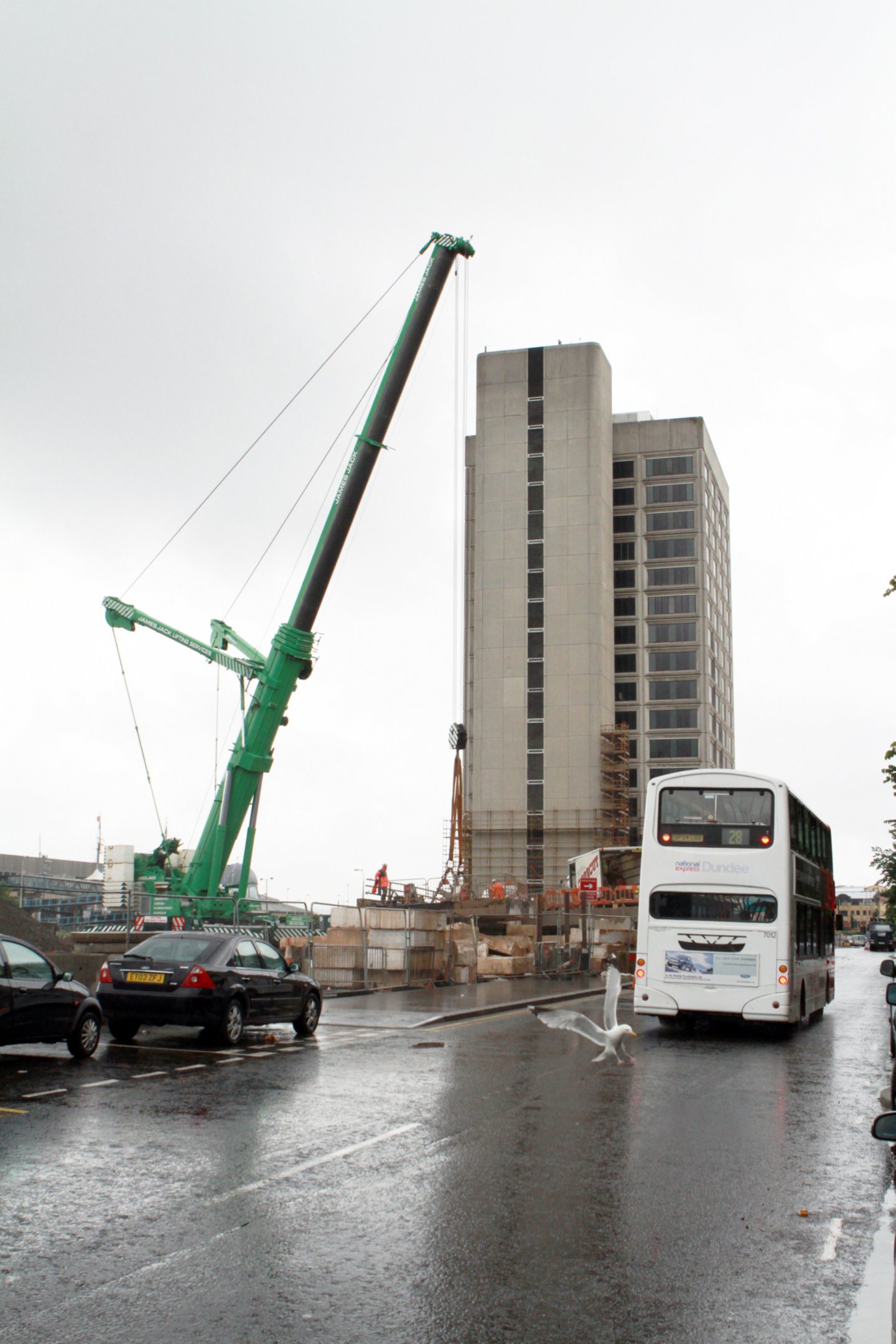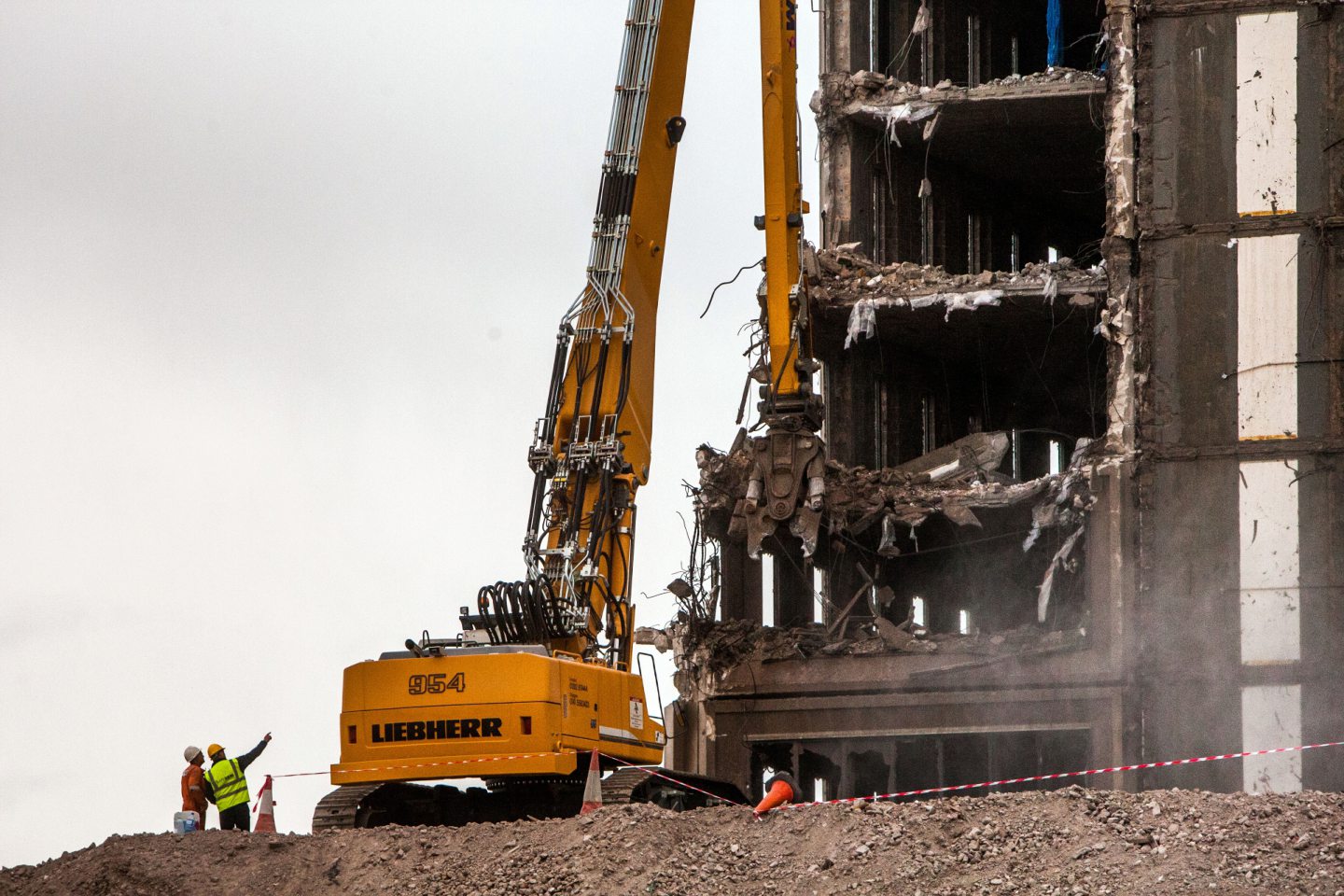Robots bit off chunks of concrete and dropped them down the lift shafts to dismantle the upper floors of Dundee’s most hated building.
Tayside House was removed brick by brick because the close proximity of the east coast railway tunnel made a controlled explosion impossible.
Contractors Safedem began the “deconstruction” by an ingenious method, though Dundonians were delighted to see the structure removed by any means necessary!

Few tears were shed when work started to dismantle the concrete giant 10 years ago.
How times have changed!
Was Tayside House a brutalist masterpiece or a concrete carbuncle?

The building split opinion in Dundee almost from the get-go!
It was an image of modernisation when it was built but over time it came to be decried as a symbol of everything that was wrong with brutalist architecture.
Bett Brothers started construction work 50 years ago, in 1972, on the ‘landfall office block’ designed by Dundee architects James Parr & Partners for property developers Ravenstone Securities and Guardian Royal Exchange.

Built for commercial use, the £2.5 million 190-foot monstrosity became the new HQ of Tayside Regional Council in 1975 when village and city were lumped together.
Tayside House did not have the meeting rooms and services that would be needed by elected members, but that would be quickly solved by adding on the podium block at the bottom of Crichton Street, which would hold council meetings.
It was positioned right in the eye line of traffic coming across the Tay Road Bridge and was originally leased for 63 years before being bought for £8.6m in 1984.

Scotland’s regions and districts were eventually replaced with 32 councils in 1996 and Dundee City Council bought out the other two councils’ interests in the building.
It was used from the mid-1990s by hundreds of Dundee City Council staff who enjoyed spectacular views over the city and the Tay estuary.
But the building was never popular with citizens and in 2000 was voted the city’s worst.

City planners eventually agreed.
The decision to demolish Tayside House was made in 2003 as the city brought forward its £1 billion transformation of the central waterfront.
A £34 million replacement, Dundee House in North Lindsay Street, opened in 2011.

Councillors approved a £1.2 million tender from Safedem for the demolition of Tayside House with asbestos removal works taking place prior to deconstruction in 2012.
Its adjoining podium block, often regarded as the little brother of Tayside House, which latterly also housed a police station, was the first to go earlier that summer.
The erection of scaffolding to Tayside House was completed by September.

The works started at roof level on a floor-by-floor basis using small robotic breakers.
These machines were operated remotely, rather than by operators sitting in a cab.
Walls, floors, beams and columns were broken up in sequence, lowered to ground level via controlled drop zones and loaded at ground level to be taken away.
The robot-controlled vehicles chewed Tayside House down to 10-storeys which became a height now low enough to allow “accelerated demolition”.
The concrete walkway which carried pedestrians over South Marketgait to the Olympia Centre, Hilton Hotel and Gala Casino was also pulled down.
Tayside House had been steadily shrinking from the Dundee skyline for months.

Safedem set a high-reach machine to work to pull down the building’s remaining floors.
A Safedem spokesman said: “Safedem has purchased a new high-reach demolition machine which will be arriving at Tayside House to allow accelerated demolition from the 10th floor down.”
A carpet of crushed concrete was laid next to the railway tunnel to cushion the ground from the impact of crushed concrete dropped by the high-reach crane.

Its demolition of the landmark in May 2013 captivated commuters.
The high-reach machine was given the nickname Muncher!
He was ready to make a meal out of the final section of the Dundee landmark.

Barry Ward, Safedem’s technical operations manager, said the high-level vehicle had been positioned on top of a pyramid of rubble and tested to ensure it would work as needed and was safe, and it was eventually declared ready for the next and final stage.
He said: “There will be an operator in the cabin and he will operate the muncher with the help of cameras at the top of the machine that will guide the mouth as it eats its way through the floors.
“We will also have people at each side of the site to ensure no one ventures on to the area so that the task can be done safely.
“This is the final stage and we hope it won’t take long for the rest of the building to come down.
“Hopefully the task will be completed in about four weeks.”

Muncher then took over – its extended neck reaching out for its mouth to first prod holes in the slabs before wrapping its jaws round them and biting them off.
It spat the morsels out on to an external drop zone where the crushed concrete was removed for infill projects in the £1 billion waterfront redevelopment.
A giant fan and hoses were set up to suppress clouds of dust and prevent them from drifting on to South Marketgait and up towards the city centre.
Older members of The Courier staff still fondly remember former colleague David McCann being nicknamed Muncher because he took so much footage of the demolition!
The moniker stuck!

Slow but steady work on the 37-year-old building transfixed commuters, who could watch it disintegrate from the road.
Muncher left Tayside House in July 2013, leaving diggers and lorries to finish the job and move the 18,000-tonne pile of rubble it left.
Tayside House still had a role to play in the future of the waterfront revolution, though.

Debris from the building was used across the £1 billion project, including infill for Craig Harbour, which would form part of the base for the V&A at Dundee.
Its removal from the city’s skyline after 40 years was followed by the demolition of the Olympia Centre, the Hilton Hotel and the Gala Casino.
More like this:
The fall of Juteopolis: How Dundee’s jute mills came tumbling down
Old Angus Hotel vs new Overgate – Dundee’s battle of the buildings
Death of the old Olympia: When iconic Dundee pool was torn down












Conversation